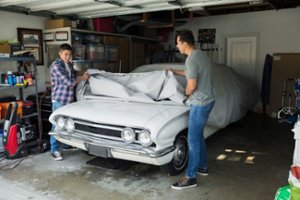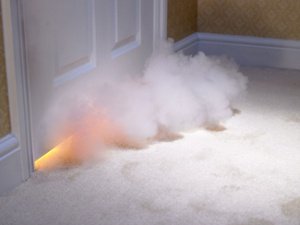
by Flagship Staff | Nov 14, 2018 | Blog
There are plenty of elements to consider when making the decision to buy a home, but those considerations shift slightly if a buyer wants to begin a family in the house. After all, parents with young kids have different needs than a single homebuyer. Here are a few things to think about when choosing a home for your growing family.
1. How much house can you afford?
Before you begin your house hunt, set your budget and get pre-approval for a mortgage. With the extra expenses homeownership creates, plus the costs associated with a baby — diapers, food, toys, and more — we suggest beginning your home search with a budget well below the maximum of your pre-approval. This will give you breathing room should you and your family need it.
2. How are the schools?
Identify high-ranking school districts and focus your search within those districts. Once your kids are school age, you can rest assured in the knowledge that you’re in the right place. Find everything you need to know about local schools by researching online.
Plus, when it comes time to move again, a house in a top-rated school district may sell quicker and at a higher price than homes in surrounding areas.
3. What’s on your home wish list?
Once you’ve found a few neighborhoods in great school districts, you can begin to narrow your search further with a list of preferences based on your lifestyle. In addition to the more obvious criteria like the number of bedrooms and square footage, consider whether you’d like to sleep close to your kids or if a master on the main floor would work better. Look at storage space, staircases, the backyard, and the layout of the living areas (and if they can be easily baby-gated). If you’re planning on watching your kids grow up in this house, ask yourself if the home meets not only your current needs but your future requirements, too.
You could also look for a property to expand or remodel based on your future family’s needs — for example, one that has a basement you could finish or an attic you could repurpose.
4. Do you like the neighborhood?
Visit the homes on your shortlist to get the whole story about a house and the surrounding area. In addition to a home tour, check out the neighborhood and the road the home is on. If you have time, take a stroll to get a feel for what it would be like to live there. Can you imagine you and your family growing up here — playing with the neighbors, trick-or-treating in the fall, or building forts in the backyard? There’s no right answer, just the right answer for your family.
With these four questions answered, you’ll be well on your way to choosing the home that incorporates all of your needs — now and in the future.

by Flagship Staff | Nov 6, 2018 | Blog
Recently, my youngest daughter, McKenna, passed her driver’s test. She absolutely loves her newfound freedom. Sometimes, a bit too much! She isn’t afraid to drive anywhere. I’m constantly reminding her that she’s a new driver and that we need to continue working together on developing her driving skills. It’s a fact: teenage drivers account for more auto accidents than any other age group.
However, I’m not going to lie, it’s easy to become complacent after teenagers get their licenses. Let’s face it; we spent months riding around with them teaching them the rules of the road. Why would we want to continue with those stressful and aggravating situations? Parental involvement is a key way to help educate and protect them.
Lately, I feel like a broken record. I’m constantly telling her:
Don’t text and drive;
Don’t speed;
Keep your music low;
Wear your seatbelt;
You’re only allowed one friend in the car; and
Text me when you get there.
Here are some other topics I’ve discussed with her. I hope you find them helpful.
1. Teen/defensive driving schools. A typical behind the wheel driver’s education class teaches the rules of the road and basic driving skills. Advanced driving school programs, such as Road America’s teen driving school focus on skills not taught in driver’s education including:
Skid prevention and control;
ABS vs. threshold breaking;
Collision avoidance and maneuvers; and
Proper vision skills.
My daughter recently participated in this class and loved it. She told me she learned so much and feels even more confident on the road. If you’re a West Bend Home and Highway policyholder, you’re eligible for discounted rates for Road America’s driving school.
2. Weather. Different weather conditions can affect how we drive. Rain, sleet, and snow affect traction and braking. What may be common sense to us may not be for new teen drivers. Before letting them drive in a new weather condition, take them somewhere safe where you can talk and they can practice new driving techniques.
3. Animals. This time of year, animals are on the move. Deer hits are very common in Wisconsin. If an animal runs out, instinct is to swerve to avoid hitting it. I constantly remind both my daughters to brake hard and fast if possible; never swerve for an animal. Swerving to avoid hitting an animal can put your teen driver and others into potentially deadly situations.
4. Intersections. Unfortunately, many drivers who get a yellow light speed up instead of slowing down. Today, I see even more people driving through red lights. This tip is critical for new and experienced drivers alike. Always check the intersection to make sure it’s clear before proceeding through on a green light. During a practice session with my daughter, I had just uttered those words and another driver went through a red light while ours was green. A split second sooner and my daughter probably would’ve been taken to the hospital.
5. Clean windshield. Trying to look through a dirty or snow-covered windshield can be dangerous. Light reflecting off a dirty or frosty windshield during sunrise and sunset can make it extremely difficult to see. When the first frost glazes their windshield or the first snowfall buries their car, show them how to clean it properly. Again, what’s common sense to you may not be to your teen.
6. Roadside assistance. If you don’t have it, consider purchasing roadside assistance for your family. For adults, a dead battery or a flat tire can be a nuisance. For a new teen driver, it can be a scary situation. Moreover, with increased highway speeds, it’s best to stay in your car. Wait for a professional’s assistance.
7. School parking lot. Depending on the size of your high school, the parking lot before and after school can be chaotic. We’ve told McKenna to get to school early and stay late. A few extra minutes before and after can make a big difference in avoiding congestion and fender benders.
8. Car accidents. Teens are three times more likely to have an accident per mile driven than adults are. Obviously, inexperience behind the wheel is the leading cause. While we hope our teens are not involved in an accident, statistics say otherwise. Discussing what to do after an accident can be helpful for both of you. I’ve already received a phone call from my daughter asking me what to do because she was rear-ended at a stoplight by another student. Luckily, it was just a bump, and there wasn’t any damage. Unfortunately, trying to have a conversation over the phone just after it happened was difficult for us. Planning can make dealing with the first accident a bit easier.
9. Car inspections. Periodically look at their car tires and instrument panels. I’ve explained to my daughters what to watch for, but I’ve learned that sometimes indicator lights are overlooked.
10. Purchase an app. Smartphone apps are available that monitor driving behaviors and send automatic text messages when teens arrive safely at their destinations. This is a good opportunity to monitor their driving, as well as offer additional teaching opportunities.
11. Graduated driver-licensing systems. These systems are designed to progress new drivers through different scenarios over time. Become familiar with your state’s program.
12. Recalculating. Driving to school, a part-time job, or a friend’s house can take new drivers through parts of your city that they’re unfamiliar with or that may present a challenging driving situation. For example, making a left hand turn at a busy intersection that doesn’t have a green arrow can be tricky. If either of these scenarios occur, consider talking to them about finding an alternative route. The next time you’re driving together, give them some guidance on how to successfully navigate through a situation that’s new to them.

by Flagship Staff | Oct 30, 2018 | Blog
Picture this. You’re driving through town in your 1969 Pontiac Firebird and everyone you pass is stopping and staring as you go by. Now if you want them to be staring because your collector car is in impeccable condition and not because your car squeals every time you touch the brakes, please take the time to make sure you’re taking proper care of your investment.
Maintenance and storage are incredibly important if you want your collector car to look like it just came off the line. Here are some maintenance and storage tips that could help:
Proper maintenance tips for your collector car
1. Make sure you’re getting regular tune-ups by someone qualified to work on the specific vehicle you have. Older vehicles should only be trusted to qualified technicians.
2. Make sure to wash your vehicle regularly as dust and dirt can hurt your paint job.
3. Try to drive your collector car at least once a month as your climate allows. A vehicle was made to be operated, and driving your collector car ensures that all the fluids are properly lubricating. You can also make sure it’s not overheating and the brakes are working correctly.
4. When parking your collector car, be sure to avoid parking on gravel or dirt. Doing so allows moisture to get into the car from the undercarriage and will cause the vehicle to degrade much faster than if it’s parked on cement.
Proper storage tips for your collector car
1. Make sure you fill your gas tank and have your oil changed before storing your car for the winter. You will also want to use a fuel stabilizer to guarantee your car is ready to go come spring.
2. Thoroughly clean your car inside and out before storing to ensure food particles left inside the car don’t attract animals and to avoid small scratches if all dirt has been removed from the exterior.
3. Use a cloth car cover, rather than a plastic one, to protect your vehicle. Plastic covers will trap moisture against your vehicle, which causes rust and corrosion.
4. Remove your spark plugs to ensure no moisture is trapped, as this will also lead to corrosion and rust.
Insurance Coverage
The most important storage and maintenance tip is to get proper insurance on your collector car. West Bend offers coverage on collector and antique vehicles as long as they meet our guidelines. We classify collector cars as vehicles that are more than 20 years old, and antiques as vehicles that were manufactured before 1950. Please contact your insurance agent for more information and to get a quote on your collector or antique vehicle.

by Flagship Staff | Oct 23, 2018 | Blog
For many, the fall season is a busy time of year. High school, college, and professional sports are in full swing. Kids are participating in homecoming festivities and many families are making trips to their local pumpkin farms. These activities don’t leave much time to get your home projects completed before the snow flies.
With the temperatures cooling down and the days getting shorter, now’s the time to prioritize your projects that need to be completed before winter settles in. Completing certain projects now can help you and your home survive winter while looking forward to the return of spring.
Here’s a list of interior and exterior projects to consider this fall.
1. Dispose of leaves. As a kid, I loved playing in the huge leaf piles in our yard, but I hated raking them. I always grumbled when my parents assigned this job to my brother and me. It did become more fun after my dad bought a leaf blower.
While raking isn’t fun, it’s best to get the job done now. Decaying leaves can ruin your lawn and make for a very messy job in spring. Check with your local city government to see if they offer a citywide leaf collection. If they do, this may make your job simpler. If this isn’t an option, check and see if your city’s Department of Public Works has a drop-off yard.
2. Clean your gutters. After all the leaves have fallen, clean out your gutters. Clogged cutters can lead to water damage due to backups or improper draining. They can also cause ice dams during the winter months. If you’re working on a ladder, make sure you have someone to keep it from moving. Also, make sure it’s the right ladder for the job. Avoid standing on the top or over-stretching. A sudden move could cause the ladder to kick out from under you. Lastly, think about what you want to do before making a quick move.
3. Inspect decks, patios, and porches. Remove debris, especially leaves, to prevent staining. Now is also a good time to clean outdoor furniture and prepare it for storage. Covering and storing it in your garage or shed is best. If that’s not possible, cover your furniture with a tarp and make sure it’s secured tightly. Winter winds can be brutal and can easily blow off your tarp. Lastly, secure loose handrails to help prevent guests from slipping and falling when entering or leaving your home during the holidays.
4. Remove garden hoses and shut off faucets. Putting away my hoses is always the last job on my list. There always seems to be one last cleaning project. If your hose(s) are stored in a covered reel, make sure you don’t forget to unscrew them from your faucet(s). Freezing temperatures can cause excess water in the hoses to expand, damaging the faucet and pipes. If you’ve turned off the water to exterior faucets in the past continue doing that. If you haven’t and have freeze resistant faucets, don’t touch them. Lack of use can cause the seals to become brittle. Turning them off now can cause them to leak into your home.
5. Remove or cover air-conditioning units. Removing air-conditioning units from your window is the best option for preventing cold winter drafts from entering your home. If removal isn’t an option, securely cover it with an insulated tarp. If you have a central air unit, consider covering it with a tarp to prevent rodents from using it as their winter home.
6. Properly store your gas-powered tools. One of the easiest things you can do is run your lawn mower out of gas. If you have leftover gas in your mower or gas can, consider adding fuel stabilizer. Adding stabilizer will prevent your gas from deteriorating over the winter months. If you add stabilizer to your lawn mower, make sure you run it for at least five minutes. Don’t forget about your other gas-powered tools such as trimmers, leaf blowers, and chainsaws.
Now is also a good time to have your blade(s) sharpened. When spring returns and the growing season starts, you’ll be ready to go.
Conversely, make sure your snow blower is filled with gas and it starts. A significant snowfall can sneak up on you quickly. If you’re experiencing problems, give your local small engine repair shop a call.
7. Inspect your home’s exterior. Walk around your home’s exterior looking for roof, siding, or foundation damage. If you find significant damage, contact your local contractor. Fixing the damage now can prevent it from getting worse.
8. Schedule a furnace inspection. Having your furnace inspected can prevent it from breaking down during the months you need it most. In addition, it can help prevent after hour service calls, which can cost a fortune. Lastly, replace your furnace filter. Replacing it regularly helps your furnace run more efficiently.
9. Have your chimney and fireplace inspected. Reading a book or drinking a cup of coffee by a warm fire is relaxing. However, every time a fire is lit creosote buildup can occur. Creosote is a residue that travels up your chimney and builds up on your flue. If that residue isn’t properly cleaned out, the chance of a fire igniting in your chimney increases. Many consider a creosote fire in the chimney one of the most dangerous fires a homeowner can experience; it can spread quickly and severely damage or destroy your entire home within minutes.
10. Clean dryer vents. Lint buildup occurs in your dryer over time, which leads to inefficiency. In addition, heating your home can cause it to dry out quickly. The dryness in your home increases static electricity. Increased lint and static electricity can lead to a fire. If your vent is accessible, take a good look to make sure it’s clear. If not, contact a professional to clean it.

by Flagship Staff | Oct 16, 2018 | Blog
Autumn is a great time of year to enjoy your new motorcycle license. Enjoying the vivid colors and sights of the season helps riders truly appreciate how this experience is simply different from riding inside a car. Unfortunately, that difference can also put new motorcycle riders at greater risk of harm during this time of year. Animals often jump out onto the road in front of vehicles during these months, and they can be harder to spot as the days get shorter. Car drivers may be protected in these instances; motorcycle riders, however, are at much greater risk of harm.
Riding a motorcycle may be a fun experience, but it can also be a risky one. Statistically, motorcycle riders are more likely to be injured in traffic collisions than drivers of other vehicles. This is primarily due to the fact that motorcycles offer less protection than cars, trucks, and other types of vehicles on the road.
This doesn’t mean you shouldn’t ride one. Although motorcycle accident statistics can be scary, they simply show it’s extra important to exercise a certain degree of caution when operating your bike. If you’re a new motorcyclist, it’s particularly important that you understand how to keep yourself safe on the road. The following tips will help.
Don’t drink and drive
Obviously, you should never operate a vehicle while under the influence of alcohol. That said, it’s worth noting that motorcycle riders tend to be vulnerable to accidents at lower BAC levels than car drivers. Thus, it’s clear that there’s no safe amount you can drink if you plan to ride a motorcycle while the alcohol is still affecting you.
Keep a safe distance
Again, motorcyclists are more likely to be injured in traffic collisions than other drivers because they don’t have the structure of a larger vehicle protecting them. That’s why it’s important to constantly maintain a safe distance between yourself and other vehicles when operating a motorcycle.
Don’t expect other drivers to see you
Unfortunately, one of the best ways to stay safe on the road is to assume that other drivers are distracted. Distracted driving is on the rise due to the ubiquity of cell phones. Additionally, because motorcycles are relatively small vehicles, they’re harder to spot on the road. Driving defensively and assuming other drivers aren’t paying attention will help you avoid dangerous situations.
Obey posted speed limits
Don’t give in to the temptation to ride your motorcycle faster than the posted speed limit. It’s always unsafe to exceed these limits. On a motorcycle, when you’re less protected than other drivers, it’s particularly dangerous.
Wear a helmet
You’re much more likely to sustain major injuries in a traffic collision if you don’t wear your helmet. Wearing it at all times when operating a motorcycle is crucial.
Be careful around turns
Motorcycle accidents are particularly common on curves and bends in the road. Thus, it’s important to exercise additional caution when driving around turns and on curvy roads. Reduce your speed if you know a turn is coming up.
Again, while the appeal of a motorcycle is easy to understand, properly operating one is also a major responsibility. Keep these points in mind and you’ll keep yourself safe out on the road.

by Flagship Staff | Oct 9, 2018 | Blog
House fires are something most homeowners live in fear of, but today’s technology can help you ensure the safety of you, your family, and your home. Here are five high-tech ways you can reduce fire risk.
1. Install smart smoke detectors for added efficiency and convenience.
Traditional smoke detectors excel at one thing in particular: beeping at the least convenient times. They also rely on older technology to detect the presence of smoke. While this doesn’t mean these traditional devices are inefficient or faulty, a smart smoke detector can offer a number of benefits that put it head and shoulders above traditional models.
Smart smoke detectors send alerts to your smartphone when they detect smoke. If they’re part of a full home security system, they’ll also notify the authorities. These devices can link to the rest of your home and perform other actions, like flashing your smart lights. Imagine if your home security cameras activated when smoke was detected, so you could discover the cause of the fire!
Some models of smart smoke detectors have built-in carbon monoxide detectors, too. If the detector picks up a cooking experiment gone wrong, you can silence it with the press of a button. Most smart alarms also send push notifications when the battery is low, instead of the ear-shattering chirp of traditional smoke alarms.
2. Install smart batteries to make your old smoke detectors more efficient.
A smart smoke detector can be a big boost to your home’s fire safety, but you might not want to replace every single smoke detector. After all, the costs can add up. The next best option is to install smart batteries in your existing detectors. Smart batteries are inexpensive alternatives to more complex smart home systems.
Rather than beeping when the battery is low, a smart battery will send a notification to your smartphone. If one alarm goes off, it can be set to trigger the other alarms with smart batteries. You can connect your alarms together like this to better secure your home against fires.
3. Turn appliances off remotely with smart plugs.
How many times have you felt your stomach drop when you can’t remember if you turned off the iron? According to the United States Fire Administration, 9.6 percent of all home fires in 2016 were caused by an electrical malfunction. Appliances that generate a lot of heat or use higher amounts of power bring a greater risk for fires.
Smart plugs allow you to flip off the power to your appliances from your phone, whether you’re at home or at the office. If you plug your more hazardous appliances (e.g. irons, hair straighteners, etc.) into the smart plug, you don’t have to worry whether you turned them off. You can check your phone to find out whether the plug is providing power, and if so, you can flip it off.
4. Prevent cooking fires with smart stovetops.
Too many house fires occur because homeowners walk away while something is on the stove. It’s understandable; after all, a watched pot never boils, and if you have to let something simmer or boil for several hours, watching it could take a while. But if the stovetop flares and no one is around to stop it, fire can easily spread throughout the home.
Smart stovetops have built-in heat and motion sensors. If no one is detected in the kitchen for a pre-set amount of time (usually around 15 minutes), then the device automatically shuts off the stovetop to reduce the risk of fires. It can also detect sudden increases in heat and shut off the stovetop if it senses a fire.
If you’re worried about it interrupting the meal, there’s no need to. Just check on the dish every few minutes; as soon as the motion sensor detects motion, it resets the countdown.
5. Link your entire system together for maximum efficiency.
A smart home system should not be a walled garden. Smart fire detectors, alarm systems, batteries, plugs, and other devices should all be connected to one another through a smart home hub, like one provided by your local Internet company. When one sounds an alert, the others should too. Imagine if your smoke detector identified carbon monoxide in the air and sent a signal that caused your smart lights to flash. Even if you didn’t hear the siren, the lights would warn you. You would also receive a notification on your smartphone.
Ensuring your entire smart home system works together, whether through the same connection protocol (like Z-Wave or Zigbee) or through the use of a smart home hub will give you the most efficient system possible.
By spacing smart home devices around your home, you can give yourself the most warning possible if there is a fire, and you can reduce the chances that a fire will happen in the first place. When it comes down to it, you want to know if a fire starts so you can protect what’s most important: yourself and your family.






